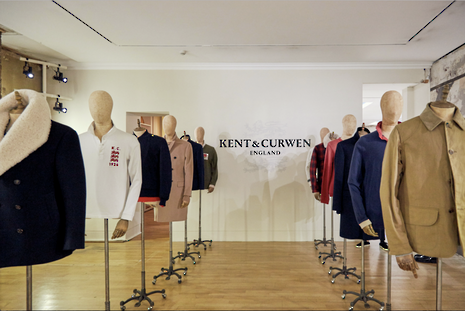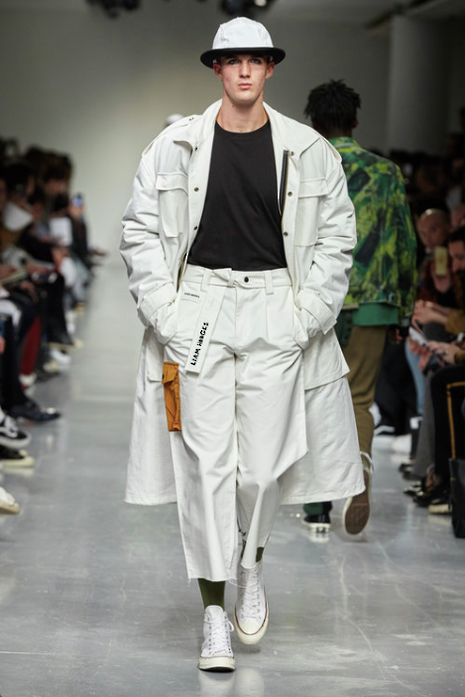London Fashion Week Men’s AW’17
Olivia Darby looks back over the events of LFWM for AW’17, where British and East Asian designers pushed the boundaries of aesthetic and mood

London Fashion Week Men’s (LFWM) Autumn/Winter has wrapped up for another year, having showcased the best of British menswear over the course of four whirlwind, fashion-loaded days. The event, as always, presented artistic creativity at its finest, from Kent & Curwen’s intricately embroidered materials to Sibling’s bright and playful twists on classic knitwear styles. However, beneath the obvious flamboyancy and extravagance, a subtle undercurrent of foreboding was perceptible throughout several collections. Many LFWM designers reflected on the political turmoil that pervaded 2016 and incorporated this turbulence into their work in a nuanced manner.

Christopher Shannon, London-based Liverpudlian designer-of-the-moment, crafted his collection with bold colours, patchwork stitching and retro vibes. This was somewhat expected; Shannon is renowned for his colour-blocked, streetwear-influenced pieces. Although the designer has chosen to veil his models previously (their faces were obscured by plastic bags during London Collections Men AW'15), his decision to use torn EU and British flags alongside distressed denim was a nod in the direction of post-Brexit despair.
The sentiment behind Liam Hodges’ ‘Dystopian Lives’ collection similarly mirrored the current political zeitgeist. His work was inspired by spoken-word artist Hector Aponysus’ quote: “Looking for a vocation in the decline of civilisation”. Despite the references to humanity’s demise, Hodges suggested that all is not lost. His models were dressed for survival, donning hard-wearing outer layers, camouflage prints, and trousers resembling bio-hazard suits. Despite the current woes of the world – climate change, political unrest, civil war – Hodges promotes resilience. The darkness can be beaten.
Then there was Charles Jeffrey LOVERBOY, whose collection has been one of the main areas of contention this LFWM. Some have heralded his talented artistry, while others have branded his work ridiculous and facetious. Whichever stance you take, there is no denying Jeffrey’s unique style. His monstrous papier-mâché creations were symbolic of something sinful and dark, evident when the choreographed dancers ran screaming from the stage. One was illustrated with an amalgam of the US and UK flags, alluding to the monsters that are Trump and Brexit. Jeffrey has demonstrated that fashion is much more than clothing. It is an expressive, creative outlet of emotion that can display political, social and cultural, as well as sartorial, elements.
“His monstrous papier-mâché creations were symbolic of something sinful and dark, evident when the choreographed dancers ran screaming from the stage”
But despite the sombre undertones, LFWM also showcased optimism, promise and positivity. From Topman’s psychedelic hues inspired by Britain’s pubbing and clubbing culture, to Bobby Abley’s playful '90s streetwear with Power Rangers influences, this year’s AW collections had unprecedented energy. With new emerging talent (Phoebe English, Edward Crutchley, Grace Wales Bonner and Craig Green are ones to watch), Britain is reaffirming its position as a forerunner in the fashion industry. Our country has certainly made mistakes this past year, but fashion has not been one of them
 Features / How sweet is the en-suite deal?13 January 2026
Features / How sweet is the en-suite deal?13 January 2026 Comment / Will the town and gown divide ever truly be resolved?12 January 2026
Comment / Will the town and gown divide ever truly be resolved?12 January 2026 News / 20 vet organisations sign letter backing Cam vet course13 January 2026
News / 20 vet organisations sign letter backing Cam vet course13 January 2026 Arts / Fact-checking R.F. Kuang’s Katabasis13 January 2026
Arts / Fact-checking R.F. Kuang’s Katabasis13 January 2026 Music / Inside Radiohead’s circle13 January 2026
Music / Inside Radiohead’s circle13 January 2026









